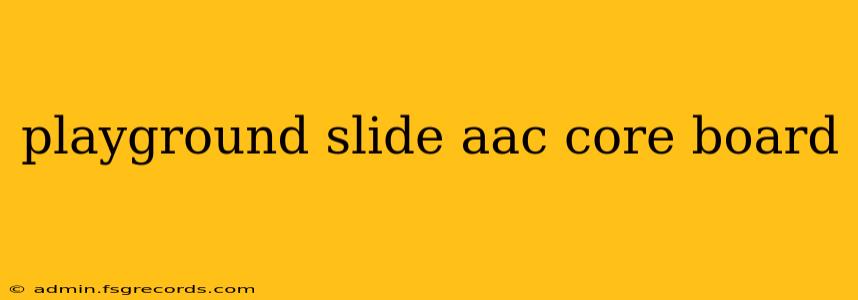For children with Autism Spectrum Disorder (ASD) or other communication challenges, playground time can be both exhilarating and frustrating. The joy of social interaction and physical activity can be hampered by difficulties expressing needs and wants. This is where the innovative combination of a playground slide and an AAC (Augmentative and Alternative Communication) core board comes into play. This powerful tool transforms the playground into a space where communication flourishes alongside fun.
Understanding the Benefits of Combining Play and Communication
Integrating AAC core boards into playground activities offers several significant advantages:
-
Increased Independence: Children can independently request assistance, express their preferences (e.g., "More swings!", "Want a drink!"), or signal when they need a break. This fosters a sense of autonomy and self-confidence, crucial for their development.
-
Enhanced Social Interaction: The ability to communicate effectively opens doors to richer social interactions with peers and adults. Instead of relying solely on nonverbal cues which can be easily misinterpreted, children can articulate their desires and initiate play.
-
Improved Communication Skills: Repeated use of the AAC core board in a playful environment strengthens communication skills organically. The association of fun activities with communication makes learning more engaging and less daunting.
-
Reduced Frustration and Meltdowns: When children can express themselves effectively, the likelihood of frustration and subsequent meltdowns significantly reduces. This leads to a more positive and enjoyable playground experience for everyone.
-
Natural Communication Setting: Unlike structured therapy sessions, the playground provides a natural and relaxed environment for communication practice. This informal setting can lead to greater ease and fluency.
Designing a Playground Slide AAC Core Board System
Several factors should be considered when implementing this system:
1. Core Board Selection:
The core board should be durable, waterproof, and easily cleaned. Consider:
-
Size and Layout: Choose a size appropriate for the child's age and abilities. A larger board offers more vocabulary options but may be less portable. The layout should be intuitive and visually appealing.
-
Vocabulary: Begin with a small, functional vocabulary focusing on common playground-related phrases and needs (e.g., "Slide!", "Help!", "Tired," "More," "Water"). Gradually expand the vocabulary as the child's skills improve.
-
Image Selection: Use high-quality, clear images that are easily recognizable and relatable to the child.
2. Slide Integration:
Several approaches are possible for integrating the core board with the slide:
-
Portable Board: A simple and versatile solution involves using a waterproof, portable core board that can be easily moved to various locations around the playground.
-
Fixed Board: For a more permanent solution, the core board can be mounted near the slide, ensuring easy access. This requires careful consideration of placement to maximize visibility and accessibility.
-
Interactive Feature: In some cases, the core board can be integrated directly into the playground equipment, perhaps a panel at the top or bottom of the slide.
3. Accessibility:
Ensure the core board is easily accessible to children with physical limitations. Consider mounting it at an appropriate height and using a system that allows for various access methods (e.g., pointing, tapping, eye gaze).
Beyond the Slide: Expanding the System
The principles of integrating AAC core boards can be extended beyond the slide to other playground equipment and activities. This holistic approach promotes consistent communication throughout the child's playground experience.
Conclusion: Promoting Play and Communication Together
The playground slide AAC core board system offers a unique opportunity to combine fun and functionality. By empowering children to communicate effectively during playtime, we enhance their independence, social skills, and overall well-being. This approach not only benefits the child but also creates a more inclusive and enjoyable environment for everyone on the playground. Remember, proper consultation with speech-language pathologists and occupational therapists is crucial for successful implementation and individualized adaptation of this system.

